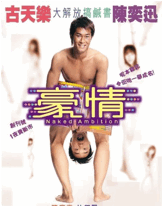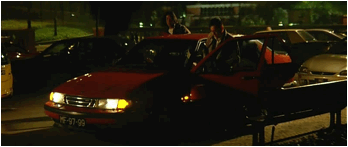
 “One Movie, Two Versions”: Post-1997 Hong Kong Cinema in Mainland China
“One Movie, Two Versions”: Post-1997 Hong Kong Cinema in Mainland China
Abstract
A large number of Hong Kong movies theatrically released in Mainland China are more or less variations of the original Hong Kong edition due to the market entry requirements and the censorship in PRC. This paper seeks to explore the interrelationship between the “one movie, two versions” phenomenon and the “one country, two systems” policy: to what extent is the long-existing multi-version practice influenced and scaled up by the unprecedented formula? And how does the phenomenon reflect the transitional nature of post-1997 Hong Kong cinema and affect its future direction? I will argue that “two-versioned” Hong Kong films are a result of economic collaboration and the ideological divergence between Hong Kong and PRC, the two ends under “two systems”. Moreover, with the illegal digital dissemination of the original movies by such means as pirate DVDs and Internet downloads, the control in PRC has become porous in the digital era which has further complicated the problem of the ideological confrontation of the “two systems”. In light of that, apart from elucidating the context, causes and impacts of the phenomenon, the interlocking relationship between market, censorship and piracy will be explored against the backdrop of the marketisation of the movie industry in China.
Note: An earlier version of this article was first published in 2010 in the Working Paper Series, David C. Lam Institute for East-West Studies, Hong Kong Baptist University.
Introduction
The “one movie, two versions” syndrome is the most attention-getting phenomenon or problem in post-1997 Hong Kong cinema’s exploration of the new-claimed Chinese mainland market. The numerous Chinese mainland-only versions with substantive changes have reflected the impact of the “one country, two systems” policy imposed on Hong Kong since 1997. This paper seeks to explore the interrelationship between the “one movie, two versions” phenomenon and the “one country, two systems” policy with the following questions:
- To what extent is the long-standing multiple-versions practice in Hong Kong cinema influenced and scaled upwards by this unprecedented formula?
- How does the phenomenon reflect the transitional nature of post-1997 Hong Kong cinema and affect its future direction?
I will argue that the two-version phenomenon is a result of the economic collaboration between Hong Kong Special Administration Region (HKSAR) and the PRC as “one country”, and also that it is a reflection of the ideological divergence of the two operating systems.
So far the topic of “two versions” had seldom been touched in depth as it is sensitive and awkward to the Chinese mainland scholars, while to the scholars outside the Mainland, they lack personal experience and access to first-hand materials (the Mainland versions are only available in the Mainland and dubbed in Mandarin). However, the alternative mainland version should not be disregarded or discarded like “a malformed twin brother” of the authentic Hong Kong movie, as a mainland media practitioner Xu (2009) maintains in his essay “Hong Kong Cinema as Transborder Visuality”,
Some Hong Kong filmmakers are persistently exploring the historical and cultural identities of Hong Kong through the images, and questioning the interrelationship between Hong Kong and the Mainland. Though their movies are screened in heavily cut and edited version in the mainland, the distorted versions still contain subversive fissures (author’s emphasis). On the other hand, we can not simplify the problem between mainland censorship and Hong Kong cinema as unilateral castration or rape imposed on the less privileged by the dominating ideology. In fact, through repairing these Hong Kong movies, the Mainland are also imagining, creating and reconstructing her understanding of Hong Kong identity and the bilateral relations.
In this paper, through an institutional analysis, I will put the dual-version phenomenon under the framework of the unprecedented “one country, two system” formula which is now practiced in Hong Kong. Based on the close examination and comparison of selected films, the media coverage, government reports, film reviews and other literatures, I will demonstrate the general differences between the two versions as the ideological divergence between Hong Kong and PRC, the sides under two systems. Since the heavy censorship has driven the authentic versions out of the theatre, the mainland audience turns to the pirated ‘authentic’ copies. In this sense, apart from elucidating the context, causes and impacts of the “two versions” phenomenon, the interlocking relationship between market, censorship and piracy will also be explored against the backdrop of marketisation of the movie industry in China.
Two-versions as a commercial expediency: a result of economic collaboration.
It should be remembered that Hong Kong studios have long been producing multiple versions of films to pass censorship in different environments, such as Malaysia, Singapore and Taiwan. PRC presents new challenges for the similar dilemma (Davis & Yeh, 2008:105).
The multiple versions for different overseas markets have been a long-tested survival tactic in Hong Kong film history. As an export-oriented industry, Hong Kong cinema has gained its fame greatly through its accurate grasp of the target markets and flexibility in catering to the audiences and the censors in various areas. The shrinkage of traditional markets in Taiwan, Singapore, Malaysia and other Southeast Asian countries after the 1998 Asian Financial Crisis has almost broken the industry chain of export-dependent Hong Kong cinema. When exploitation of the new mainland market becomes a matter of life and death, such a reluctant compromise with market entry limitations is totally understandable as a measure of expediency. In this light, since the 1997 reunification, the Hong Kong film industry has begun to shift its attention to the Mainland as its major ‘overseas’ market. Meanwhile, the PRC has also slowly started the marketisation of the once totally state-owned film industry, as its commercial value, apart from its propaganda function, has now been realised and acknowledged. The burgeoning Mainland market needs more movies to attract the audiences back to the theatres while nearly ‘laid-off’ Hong Kong filmmakers are desperately looking for new markets to keep their cameras rolling. I am going to first briefly address the tradition of using multiple-versions in the Hong Kong film industry to accommodate to different overseas market, and then focus on its abuse in exploiting the Mainland market.
Multiple-versions as a Survival Tactic of Hong Kong cinema
Multiple-versions are not an unusual practice in film history and it happens throughout the world. In the case of the export-oriented, entertaining mechanism like Hong Kong cinema, the alternative version is usually made to placate the censors of specific overseas markets. In early 1990, for the sake of international markets like Europe and other Asian countries, the internationally known mainland actress Gong Li was chosen to star in a Hong Kong comedy God of Gamblers III: Back to Shanghai (1991), However, according to Taiwan film policies at that moment, the PRC citizens were strictly forbidden to appear on the domestic screens of the ROC (Republic of China), even if the movie was Hong Kong made. Therefore, a special version was made for Taiwan market alone, with a much less famous Taiwanese singer replacing the mainland actress. Within one story, a few extra shots using a Taiwanese local actress to meet the import requirements ensure that the cost-return ratio is perfectly calculated and maximised. These are typical Hong Kong tactics for surviving between the gaps.
|
|
Another example is the movie Infernal Affairs (2002), providing two different endings in its DVD release. The original ending climaxes with the death of the undercover policeman, while his murderer, a police-infiltrated triad member walks off as a free man. In contrast, the alternative ending conveys a more clear-cut message with the arrest of the murderer red-handed. ‘Good’ has to be rewarded while ‘Bad’ needs to be punished. Since Infernal Affairs was made in the post-1997 era, many had mistakenly blamed the PRC censors for the faulty ending while in fact the film had never been officially screened in the Mainland theatres. This ending was initially made for the Malaysian market and as the head of Media Asia Group John Chong recalled:
In Malaysia they set the rules not allowing criminals to be at large in the movies. In shooting Infernal Affairs, I called Andrew [the director] asking him what we should do if Ming ends up a freeman. It turns out our directors are quite experienced with those rules in overseas market and he told me had already prepared an alternative version as Ming steps out of the elevator hands up and arrested. This ending is also used in the Mainland. Some said it was to accommodate to the restrictions in the Mainland. It was not. It is the market. Only this way can it work in the market. (Quoted from Cheuk, 2008)
Infernal Affairs was made in 2002 when the Hong Kong film industry was at its bottom as it had almost lost all its Southeast Asia market since the 1998 Asia Financial Crisis. When the PRC came to lend a hand with the CEPA (Closer Economic Partnership Agreement) implemented since January 1 2004, the industry started to shift its attention on the mainland market. Before CEPA, Hong Kong films were still regarded as foreign films to the Mainland and had to compete with Hollywood and other foreign movies for the twenty profit-sharing import quota every year (the quota used to be ten before 2001 China’s accession to WTO) even though since the 1997 handover Hong Kong has become a SAR of the PRC. The unification of sovereignties did not bring the two territories any closer under the two systems, and its influence on the Hong Kong film industry seemed not very obvious in the first few years after the handover as Hong Kong films were kept outside the mainland China market. However, through the efforts of the Hong Kong filmmakers after sending delegations to Beijing to negotiate for the ‘national status’ of Hong Kong cinema in the PRC, the preferential policies on mainland distribution and exhibition of Hong Kong films are included in CEPA. Hong-Kong-made Chinese-language films can be imported to mainland China on a profit-sharing basis exempt from the annual 20 foreign film quotas, and co-productions with the mainland can be distributed as domestic films in China. In terms of box office revenue, only 15 per cent goes to profit-sharing imports but 45 per cent goes to the co-productions (Wai, 2007). This was to be a stimulant to the failing Hong Kong film industry.
In fact, just as desperately as Hong Kong film industry that needs the new market of the Mainland, the Mainland also needs Hong Kong cinema to fuel its marketisation of the moribund state-owned film industry. With the adaptation of a market economy in the PRC since the early 1990s, the commercial value of films has been gradually realised and emphasised. Since 1994, the PRC started to introduce 10 Hollywood movies on a profit-sharing basis every year, and the quota has been increased to 20 since the 2001 after its entry to WTO. From 2002, a top-down, ‘Great Leap Forward’ like campaign of establishing national theatre chain system was launched in an effort to improve the to the infrastructure for film exhibition. In this theatre building and renovating campaign, Hong Kong capital and management experiences have taken a leading role. According to CEPA, Hong Kong service suppliers are permitted to construct, renovate and operate cinema theatres in the Mainland on an equity joint venture or contractual joint venture basis (the Hong Kong stakes allowed have gone up from 50 per cent in the beginning to fully-owned at present).
By the end of 2009, China has established altogether 34 theatre chains with nearly 5000 screens, five times increase in eight years. The total box office revenue has augmented from less than 1 billion RMB in 2002 to 6.2 billion RMB (about 0.9 billion USD) in 2009 (Xinhua news agency, 2010). The profit-blowouts in Mainland film industry are the result of economic collaboration between Hong Kong and the Mainland with mutual benefits. However, the unexpected and still yet-to-be-solved side products are these large numbers of mutated Hong Kong films screened in the Mainland theatres, diminishing the reputation of Hong Kong cinema.
Mainland Metamorphosis of Hong Kong movies
In 2004, among those films that first hit the mainland theatres under CEPA, The Inescapable Snare (Tian Luo Di Wang, literally meaning an escape-proof dragnet) was one of them. It is a very cost-effective repackaging of a 2003 Hong Kong film Naked Ambition (2003). The original Hong Kong version tells a story about two young college graduates who overcome bias and prejudice to rise from miserable magazine writers and editors to big shots in the local porn industry. It was rated as Category III in Hong Kong (adult only film) due to the nudity and obscenity. In order to take the advantage of the preferential treatment brought by CEPA, the pragmatic and adaptable Hong Kong studio cleverly remade it into a normative Mainland-Hong Kong co-production. The ‘indecent’ rag to riches story of ‘porn kings’ was ‘whitewashed’ into an educating morality tale on how Hong Kong police, together with Mainland Public Security Ministry, crack down on pornographic publications and prostitutions. The supporting role of Hong Kong police officer in the original film becomes the leading hero in the mainland version, assisted by a mainland undercover policewoman who never appears in the Hong Kong version. Obviously, this mainland female role was abruptly squeezed in to fulfill the requirement of Hong Kong-mainland crew ratio in co-productions. This opportunistic experiment was criticised by a Hong Kong critic as “the most subversive act” and “complete revision of the original ideology” (Ye, 2009), but more importantly, it reflects the jerry-building attitude in quickly taking advantage of the newly claimed ‘national status’ in the Mainland market.
|
|
In fact, in order to avoid being classified as ‘spirit pollution’ to the mainland socialist society, quite a few Hong Kong films had carried out at least some or in other cases, many kinds of “cosmetic surgery” (netease.com) self-consciously and voluntarily so as to pass the strict screening of the State Administration of Radio, Film and Television (SARFT) before making their presences at Mainland theatres. Besides changing a more uplifting or blunt title, based on the Chinese mainland netizens’ scattered comments on the revised version, these surgeries usually include:
- the overall detoxification of the nudity, sex, violence and politically sensitive topics
- minor skin uplifting (the good gets rewarded and the bad never ends up well—all the criminals will turn themselves in if not being arrested)
- bleaching (characters in the crime movies would unexpectedly reveal their identities as a police undercover in the end, so that all the bad behaviours are covered in the name of “seeking justice”)
- major body treatment like liposuction (cutting out the sensitive contents, be it political, religious, or superstitious) or even
- bone contouring (repackaging the whole film almost beyond recognition like turning a crime movie into a anti-crime moral story).
In a nutshell, all these efforts are to serve one goal only – to put a potential morally contaminating HKSAR film generally in line with the Central People’s Government. As a spokesman for SARFT explains, “Movies are cultural products, and against China’s particular national background, under a socialist ideology, we must conscientiously carry out the inspections according to our value system” (Martinsen, 2005).
These arbitrary ‘cosmetic surgeries’ have provide the Hong Kong films a shortcut to the Mainland screens but has sometimes resulted in a deviation of the filmmakers original creation. The winner of 2004 Hong Kong Film Award, Running on Karma (2003) was so introduced to the Mainland with substantial cuts, which have fundamentally degraded the philosophical, thought-provoking movie to a senseless commercial film selling stars and special effects make-up (a prosthetic muscle suit to make the hero look huge, like Schwarzenegger). The original story is unfolded around the protagonist Biggie’s unusual ability of seeing karma – a Buddhist teaching on the effects of a person’s actions that determine one’s destiny in one’s reincarnation. However, according to the official ideology of the PRC, this religious doctrine is regarded as superstition and should be banned from the silver screen, so all parts conveying or reflecting the idea of karma, about 15 minutes in total are cut from the 98 minute movie. The remaining 83 minute ‘non-superstitious’ story turns out to be superficial, motivated only by an inexplicit secular love between a man and a woman, leaving an illogical and broken plotline for the Mainland audience to baffle about the story and its successes in both Hong Kong theatres and film festivals.
|
|
Another example is One Nite in Mongkok (2004), a crime thriller about the story of a prostitute and killer struggling for a living in Hong Kong. In order not to antagonise the censors, an inter-title was added to indicate that the story happens in 1996 to pretend that all things bad happened in the ‘corrupted’ British Hong Kong era. This is an expansion of ‘new society–old society’ dichotomy from the PRC to HKSAR (Xu, 2009). In PRC official historiography, the founding of the PRC in 1949 has always been referred to as the watershed between new and old societies, and now in Hong Kong, 1997. Since all the crimes belong to the ‘old Hong Kong’ in 1996, which have nothing to do with the ‘new’ one, the film avoids suspicion of challenging the sustained stability in post-handover Hong Kong as part of ‘new China’. Rebellion (2009) set in the ‘inter-titled’ 1996 is full of cutting-edge cell phones and the characters even comments on the Iraq War which broke out seven years later. If the film were distributed in the American market, it probably would be criticised for its rejection of the cause-effect relation between the 9/11 Attack and the Iraq War.
Although stringent film censorship in PRC has caused a greater challenge to the Hong Kong cinema, generally speaking, the ordeal is not comparable to the opportunity to revitalise the industry with its advantage of a privileged access to the mainland market not enjoyed by their Hollywood counterparts.
In fact, since the 1997 reunification, the intertwined interests of Hong Kong and China are not limited to the film industry but in many other aspects as well. As Hong Kong scholar Chan admitted “Hong Kong’s growing economic dependence on the Chinese market is a received wisdom” and a strong economic partnership that is mutually beneficial (Chan, 2004: 50). Post-1997, Hong Kong cinema, as Pang (2007) maintained,
is a utilitarian form of nationalism, facilitated less culturally than economically, so that this nationalization is economically driven and therefore compliant with globalization (p.424).
In the first years after the 1997 handover, with the 1998 Asian Financial Crisis, Hong Kong was more economically vexed than politically because of the noninterventionist approach adopted by Beijing. Since Beijing’s first task is to maintain the stability and prosperity in Hong Kong as promised in promoting the “one country, two systems” formula, its “benevolent stance” towards HKSAR was described as “rather unexpected” by alert Hong Kong scholars (Chan, 2004: 36). They concluded that Beijing’s attitude in the first years after the handover as “strongly marked by both pragmatism and a keen sense of political prudence” (Ibid: 35) and it is also pragmatism that has propelled Hong Kong to welcome the Mainland on an economic ground though still alienating or feeling alienated culturally and ideologically in the unacquainted motherland. The mutation of dual-versioned Hong Kong films in the Mainland markets is a result of the opportunistic ‘quick money mentality’ in the Mainland-Hong Kong economic collaboration and a reflection of the irreconcilable political divergence in their correlation as well. Two-versions highlight the political divergence: a reflection of HKSAR-PRC correlation
Despite the intertwined interests and mutual financial benefits in the economic collaboration, PRC and Hong Kong still guard against each other for political reasons. While PRC is taking a defending or intimidating stance towards the flooding of Hong Kong films, some Hong Kong filmmakers are also intentionally provoking through their social fable or political allegory genre of films. Being a special administration region of PRC, Hong Kong is trying to grasp every opportunity to uphold its subjectivity through its cinema, sometimes intentionally, to express their discontentment, defiance, and even to provoke the PRC censor. Due to these divergences, the proposal to establish film rating regime in the PRC seems to be inadequate to the “two-versions” which, to some extent, serve to be a specimen for studying Hong Kong-PRC correlation under “one country, two systems”.
Persecuted or Provoking: “Category E” Hong Kong movies
They start from a non-progressive standpoint, ranging from the frankly reactionary through the conciliatory to the mildly critical; they have been worked upon, and work, in such a real way that there is a noticeable gap, a dislocation, between the starting point and the finished product (Comilli & Narboni, 1982: 819)
A ‘Category E’ movie is a category in ideological criticism proposed in the late 1960s by Jean-Luc Z. Comilli and Jean Narboni. Among the ‘A-G taxonomy’ of films in the article Cinema/ Ideology/ Criticism, Category E films are
films which seem at first sight to belong firmly within the ideology and to be completely under its sway, but which turn out to be so only in an ambiguous manner (Comilli & Narboni, 1982: 819).
Taiwanese scholar Robert Ru-Shou Chen (1994) interpreted them as “the Fifth films” surmounting the interrelated binaries of the first four kinds, namely, A-commercial film, B- reactionary film, C- art film, D- political film. In a word, a Category E film is like a commercial film inlaid with obscure social satires or political allegories, and only the ‘insiders’ among the audiences will receive the message and nod with a knowing smile.
This “political expediency” (Bordwell & Thompson, 1988: 919) has been frequently employed in the post-1997 Hong Kong cinema: Wong Kar Wai’s film 2046 (2004) refers to the last year before Hong Kong’s fifty years special self-governance status expires; a repeatedly appeared car plate in Johnnie To’s Exiled (2006), a story set in Macao, is “MF-97-99”, the particular year for Hong Kong and Macao reunited with PRC respectively; and the prolonged close-up to a car plate ‘CH6489’ in a comedy Men Suddenly in Black (2003), reminding the June Fourth incident in 1989 (a.k.a. the Tiananmen Square Massacre) which still remains a taboo in the Mainland.
|
|
It would be hard to judge the real intentions for all these associations but it is clear that the filmmakers are giving vent to their inextricable tangle of feelings towards the handover, and their status of being a SAR of socialist PRC. In this case, the edited mainland version may testify the persecution’ of these ‘Category E’ Hong Kong films as well as their ‘provocation’ as they “throw up obstacles in the way of the ideology, causing it to swerve and go off course” (Comilli & Narboni, 1982: 819), or in Godard’s frequently cited statement “not making political films, but rather making films politically” (quoted in Monaco, 2004:174).
Johnnie To’s Election (2005, literally Chinese title Black Society, a euphemism for Triads society), utilises the masquerade of triad election to “directly mock the lack of democracy in Hong Kong” (Pang, 2007). The director himself has repeatedly emphasised that this film was made with no intention to entering the Mainland market, as it reflects the changes in Hong Kong society and “it’s bound to have a hint of the political environment” (To, 2005), but as a post-CEPA production, it is quite understandable that anyhow a Mainland version entitled Long Cheng Sui Yue (literally, Times at Dragon Town) was still released simultaneously on October 20, 2005. No matter it is a result of the official censorship by SARFT or the commercial self-censoring by the Hong Kong studios, the obvious elimination or editing in Long Cheng Sui Yue has made what concealed in Election more conspicuous. In a word, the alterative version unexpectedly serves to highlight the hidden messages in the authentic one.
As its English title Election indicates, this crime film has a bigger ambition than a simple portrait of the triad society. The story unfolds around the blood-soaked election of a triad chairman (which resulted in a Category III rating in Hong Kong), and struggling for the Dragon Head Baton – the emblem of triad power; but in fact it embodies the appeal for democracy and universal suffrage in the SAR by using the triad society “as a microcosm of Hong Kong and its particular status as a self-governing city within the Chinese state” (Teo, 2007: 179) and the reflective thinking on the changes in post-1997 Hong Kong in terms of its relation to the Mainland. Despite the different Chinese titles, there are altogether over ten major cuts or changes in the mainland version. Besides those funny and annoying, cliché-like ‘uplifting changes’ of all bad guys being arrested and old people educating the youth not to join the organised crime, some of them have revealed certain aspects about the status quo of Hong Kong under ‘one country, two systems’. These revelations involving areas from political claims to the people’s livelihood all point to the inquiry and negotiation on the identity of Hong Kong being a SAR of the PRC.
First of all, a line which was ultimately cut serves as a beacon to bring out the theme or the essence of the original: an anti-triad police officer says, “The Triad started electing their chairman even earlier than we elect our chief executive.” In an interview, director To states clearly the relation of his motive of making the film with Hong Kong’s anti-Article 23 demonstration in 1 July Marches 2003, after which the universal suffrage became the focus of political controversy, “I feel we lost out after 1997. We should have found our targets after the 2003 demonstration” (To, 2005) and those targets are the universal suffrage and the autonomy of Hong Kong. Towards the end of 2003, after the July 1 marches successfully putting Article 23 which legislates against acts such as treason, subversion, secession and sedition ‘temporarily suspended’, the focal point has shifted to the dispute of how subsequent Chief Executives get elected. Presumably there is some consideration on the impact the universal suffrage in Hong Kong that would probably create on the one party rule in Mainland China, so in 2004, the Central Government of PRC had ruled out universal suffrage in 2007, but eventually in December 2007 promised to allow universal suffrage in 2017 while the Hong Kong pro-democracy camp is still pushing for this to happen in 2012.
Similarly, a slight change in one not so important dialogue shed light on another noticeable social phenomenon under ‘one country two systems’: the influx of Mainland pregnant women giving birth in HKSAR to evade the one-child policy. In the movie, a triad member reminds a mainland liaison how he has helped the mainlander’s wife to be admitted to hospital in Hong Kong for childbirth so the baby is a permanent Hong Kong resident. However, in the mainland version his words are revised to simply “help sending your wife to the hospital” to sidestep the sensitive topic. According to a judicial interpretation of the Basic Law made by Hong Kong Supreme Court in July 2001, all children born in Hong Kong are entitled to birthright of abode (since Hong Kong is not an independent nation, there are no provisions for Hong Kong citizenship). Then the Individual Visit Scheme began in 2003 that allows travelers from Mainland China for brief visits to the SARs on an individual basis intended to boost the local tourism but which actually triggered the ‘mainland mother rush’. The number of babies born in Hong Kong by mainland mothers surged from 7810 in 2001 to 19538 in 2005 almost 2.5 times (Legislative Council document, 2007).
Most noteworthy, is the omission of an undercover police officer in the original while adding another one in the mainland version. In the Mainland-ready ending, as usual the panacea of turning one of the criminals into an undercover policeman to justify all crimes employed, but conspicuously the scene of a Mainland police officer talking to a triad member, revealing that he was sent to Hong Kong to infiltrate the triad before 1997 and now is asking his old acquaintance to cooperate with the Mainland police was removed. In fact, this is the most important clue leading to the sequel of the movie, Election 2 (literally Chinese title: Triad: Value Peace Most, 2006) centering on the PRC Central Government coercing the protagonist to be the puppet chairman of the triad society while he himself attempts to go ‘clean’ as a legitimate businessman.
|
Of course, as “the most directly political film made in Hong Kong in the post-97 era” (Ibid), Election 2 was never officially screened in the Mainland while Election, the less political or suspicious, but still a provoking Category E film, was shown with considerable revisions. These revisions were claimed to be made to accommodate the Mainland market presently lacks a film classification system since Election is rated as an adult only movie in Hong Kong due to the violence (Xinhuanet.com, 2005).
Differences in Film Regulatory Regimes: The Film Rating System vs. Censorship
Motion picture rating systems are a general international practice for film regulation, be it the ‘industry self-regulation’ as adopted in United States, United Kingdom, Japan and South Korea; or the ‘command-and-control regulation’ which is a government conduct as in Australia, Canada, France, India, Singapore, Malaysia and Hong Kong (So, 2006). The regulation of film contents is to protect children and young people from exposure to inappropriate materials, but equally (if not more) important, the rights of the adult audience as well as the filmmakers should not be ignored. However, so far in PRC, instead of a rating system, the government executes its control on film through a one-size-for-all censorship. This difference in film regulatory regimes of Mainland and Hong Kong is mostly referred to as the reason for “one movie, two versions” (Martinsen, 2005).
The motion picture rating system in Hong Kong was established in 1988 and revised in 1995. According to it, any movie shown publicly in Hong Kong theatres is issued a rating among the following four:
CAT I— Suitable For All Ages
CAT IIA— Not Suitable For Children
CAT IIB— Not Suitable for Young Persons and Children
CAT III— Persons Aged 18 and Above Only
Since 18+ restricted Category III films will result in the departure of some audiences, for mature business mechanisms like Hong Kong cinema, the goal of maximising financial return has led to a tendency towards not so exclusive IIB movies, unless the films are targeting an adult audience only with excessive violence and explicit nudity and sex as their selling points.
Under China’s “one movie for all ages” regulation, CAT IIB seems to be the upper limit as minors (even children) are admitted to the theatre with or without adult company. Many of the recent high-profile Chinese domestic blockbusters by the first class Chinese directors such as Zhang Yimou’s House of Flying Daggers (2004), Curse of Golden Flower (2006); and Feng Xiaogang’s Banquet (2006) all contain substantial sex scene and violence. All of them are rated as Category IIB in Hong Kong to which parental guidance is required for viewers under 17 years old. But in Mainland theatres, these movies are open to everyone without any warning. In fact, violence scenes inappropriate to the minors can often be found in publicly released films in the Mainland no matter it is made in Hong Kong or mainland China. Back in 1988, when British Hong Kong government first introduced the film rating system, the first movie being issued at Cat III rating is Men Behind the Sun (1988. Chinese title Hei Tai Yang 731, literally meaning “Black Sun: 731”) which graphically depicts the secret biological weapons experimentations conducted upon the Chinese and Soviet prisoners by the Unit 731 of the Imperial Japanese Army during WWII. Despite the cruel and bloody scenes that shocked the Hong Kong censors, this movie was publicly screened in the mainland and many schools had even organised their pupils and students to watch it as part of their extra-curriculum patriotism education (Wei, 2006).
It is self-evident that violence is not the real cultural minefield in PRC film regulation while being politically correct is more overwhelming. Neither should erotica be regarded as the real concern. The zigzags of Lust, Caution (Se Jie, 2007) by Taiwanese director Ang Lee in the mainland had unveiled the truth behind the pretext of a yet-to-come rating system. It is a very controversial movie for its excessive number of sex scenes has roused nation-wide calling on establishing a film classification system in China but only to push the dream further away from being realised. Director Ang Lee had openly admitted that besides visually cleaning up the sex and violence in the film for the mainland “clean version”, he had to also change the dialogue in the Mainland version for political reasons (Metro, 2007). Set in WWII Hong Kong and Japanese-occupied Shanghai, Lust, Caution is about a group of patriotic university students plotting to assassinate a high-ranking official in the puppet government. The attractive young woman sent to seduce him ends up falling for the official and reveals the plan when it is about to launch. According to Lee (Metro, 2007) her life-changing instruction “go quickly” was changed into somewhat moderate “let’s go”, to make her intentions less ambiguous because “Chinese censors were worried about the backlash from the plot line of a supposedly patriotic activist aiding a Japanese collaborator”. Lee acknowledged that this was an artistic compromise for the mainland market. “I didn’t want to become a martyr,” he said (Ibid).
|
The censorship of this film did not end with the edited version. Not long after the sensation of Lust, Caution, the leading actress Tang Wei who had just won the Best New Performer in the Taiwan Golden Horse Awards for her role as the undercover student was stunningly blacklisted by the SARFT without any legal procedures or explicit explanations. Her TV advertisements were withdrawn from all Mainland television stations and she was totally deprived of the right to work as an actress in China. It was reported that the “glorification of traitors and insult to patriots” (Callick, 2008) message in the movie was sensed by a high-ranking veteran Communist Party cadre and as a mainland actress, Tang Wei was banned from working in her own country for “glorifying traitors” (Macartney, 2008). This happened suddenly and immediately steered the policy agenda from the lack of a classification regime to the self-contradictory manner in which SARFT operated within its arbitrary administrative interference without legal grounds.
From the bitter experiences of Lust, Caution, it becomes obvious that the problem with arbitrary enforcement of the rules is more dangerous than ambiguous legal provisions in film regulation. The fewer rules are clearly stipulated, the more films are subject to unpredictable censorship. Fundamentally, the difference between the two regulating measures – the film rating system and the censorship adapted respectively in HKSAR and the PRC – lies in that the rating system protects the interests of the public as well as the filmmakers, while censorship actually protects the power of the government authority in the name of sustaining a healthy and harmonious society. In light of the possibility of the subjective judgment of ‘insulting Chinese people’ or ‘glorifying the traitors’, a yet-to-come film rating system seems not completely capable of changing much of the awkward double presentation of Hong Kong films in the Mainland. Therefore at present, the only way for the mainland audience to enjoy the authentic full version is ironically through pirated copies though the double-edged effect of film piracy has shown great impacts on both film consumption and production.
The Impacts of Two-version on Hong Kong film consumption and production
The aforementioned Ang Lee film Lust, Caution has aroused a nationwide urge for the establishment of a film classification regime in PRC, but before the day arrives when Mainland audiences can watch Lust at local theatres as their Hong Kong counterparts do, they watch it at home with pirated copies either in form of DVD or Internet download. In fact, since the alternative mainland versions of many Hong Kong films have diminished the appeal of cinema-going, the ‘illicit’ copies of the original are prevalent among mainland viewers which can be favorably interpreted as promoting the dissemination of authenticity. However, the consumers’ choice of the pirated authentic versions outside of the theatre has a great negative impact on the filmmakers whose investment return is still dependent on the box office revenue. Therefore, Hong Kong cinema is gradually showing a tendency of self-imposed censorship to avoid revisions after submission for screen permits since the alternative versions tend to loss profit to the pirated ‘authentic’ version.
Polarized consumption: theatrical censored version vs. pirated “authentic” version
The rise of film ‘piracy’ can be explained by highlighting a number of socio-economic, cultural, political and technological changes that, in combination, create both the demand for such products and the means by which it can be more readily satisfied (Yar, 2005).
With the dispersion of various forms of audiovisual technologies, nowadays a film is no longer confined to the celluloid; therefore, to watch a movie does not necessarily mean going to the theatre. Constrained by the strict film regulation in both quantity and content, the mainland audiences are no doubt pathetic, but under the government’s connivance of piracy, they are able to enjoy almost any movie they want through digital dissemination. In this sense, the pathetic becomes the privileged.
Early in the 1980s, when film was still deemed a propaganda tool in PRC, Hong Kong entertaining films were mainly introduced to the Mainland through pirated copies, from video cassettes to VCDs and DVDs. In contrast to the stagnant state-owned cinemas, the brisk business of the mushrooming video parlors had played an important role in “remedial film education” of the mainland audience who had been isolated from the outside world for decades from the establishment of the PRC in 1949 to the open door policy adopted in 1978. Since 1980s, besides the limited number of imported films, a lot of Hong Kong films began to be introduced into the Mainland through various means, such as video tapes, VCDs and then DVDs. Usually there was a “time lag” between the Mainland screening and Hong Kong release which also provided a niche for piracy profit.
Since the implementation of CEPA in 2004 when Hong Kong films flooded into the Mainland markets; as domestic products released almost simultaneously, the “time lag” is now replaced with the “content discount” in the censored versions. Scholars have introduced the term “cultural discount” (Hoskins & Mirus, 1988: 500) to describe the varied reception of media products travelling across different cultures, especially the diminished appeal of foreign media products resulting from the cultural differences between the viewers and the products. However, here in the case of the theatrical consumption of Hong Kong films in the mainland, there emerges this unusual ‘content discount’ due to the ideological difference under two political systems, in spite of the cultural proximity of being of one nation.
As the mainland audiences had learned their lessons from being deceived by the ‘discounted’ theatrical version, and turned away to only pirated ‘authentic’ films one after another, the rapidly expanding mainland film market has taken on an unusually polarised consumption model. On the one hand, a spurt of growth in total box office revenue demonstrates the growing habit of cinema-going as a fashionable urban middle-class life style while on the other, some quite conscious movie fans have developed a habit of waiting for the illicit DVD or Internet downloads of Hong Kong full versions, which results in the unaffected proliferation of film piracy. Some research on the piracy epidemic has pointed out that, “there is a close correlation between per capita GDP and piracy levels, with the highest piracy rates to be found in those countries with the lowest incomes, and vice versa” (Choi 1999: 2, quoted in Yar 2005). This is also true with China whose per capita GDP ranks behind 100 among the world. However, with an overall GDP ranking No.2 in the world and the rapid expansion of urban middle class as well as their increasing disposable personal income (DPI), mainland cinema-goers are actually a potential cash cow for the film industry. Their choice of watching pirate copies is a choice of content over price which can even be seen as a consumer revolt again the censored alternative versions screened in the theatres. In light of this background, movie piracy in the Mainland is to great extent the negative consequence of censorship based on the lingering conception of film as an apparatus for ideological control than a problem of the enforcementof copyright law. Though in fact, alleviated by the digital dissemination of illicit contents, this control has become a leaky bucket in the digital era.
In the article The global ‘epidemic’ of movie ‘piracy’: crime-wave or social construction?, Yar (2005) maintains that piracy can be regarded “as a social construction whose increase can be attributed to shifting legal, political and criminal justice contexts which serve to ‘produce’ the problem of ‘piracy’ in its current scope and scale”. This argument is based on defining piracy as “the unauthorized copying and distribution (often, though not necessarily, for commercial gain) of copyrighted content” based on the intellectual property law (ibid), but in the case of the PRC, without any intention to justify or legitimatise piracy, we must admit that, as ideological censorship is intensely involved in film production and exhibition, the definition of piracy is problematised as sometimes the officially authorised versions are actually ‘frauds’ of the original; hence the role of piracy as ‘social construction’ becomes more striking.
Although the contradistinction of the two versions simultaneously screened publicly and circulated underground has materialised and visualized, this control as self-deceiving hypocrisy on the level of film consumption, it is still annoying hurdles to the film production in not only jeopardising the box-office revenue but also challenging some filmmakers’ conscience of safeguarding their artistic integrity. Shinjuku Incident (2009) starring Jackie Chan was withdrawn from the tempting mainland market without even bothering to submit the film for approval. Though initially registered as a Hong Kong-Mainland coproduction, and enlisted in the repertoire of China Film Group Corporation official website, this movie had ended up with reaching the Mainland audiences only through pirated copies.
|
The director Derek Yee explained his decision of not releasing the movie in mainland China because China does not have a movie rating system while toning down or cutting the violence would hurt the integrity of the movie (Lee, 2009). However, contrary to his explanation, a cut version about 19 minutes shorter was released in Singapore and Malaysia, two places well known as conservative in their film censorship policies. In addressing the issue, Mainland film critics pointed out that apart from the concerns of the violence and film rating, the real obstructions for Shinjuku Incident to enter the Mainland are the sensitive topic of illegal Chinese immigrants in Japan, and the strident theme of ‘Chinese don’t fight Chinese’ spoken out openly in the movie, both “inviting suspicion of insulting the Chinese people” (Ma, 2009). Quite different from Jackie Chan’s usual trademark action movie, Shinjuku Incident is closer to a drama. It realistically portrays the ignominious struggling life of illegal Chinese immigrants in Japan. The direct exposure of the deep-rooted bad demeanors of the Chinese people and cruel reality of the conflicts and discrimination among the Japanese, the established Chinese immigrants, and the illegal, indigent newcomers may all easily antagonise the mainland censors.
Disappearing ‘two-versions’: an indication of self-censoring of Hong Kong cinema
No matter how ‘socially constructive’ those pirated original versions seem to be to the Mainland film consumption environment, the implications of digital dissemination on Hong Kong filmmakers are double-edged. On the one hand, its contribution in clearing up the misunderstanding and doubts of Hong Kong cinema caused by its mainland mutations should not be neglected; on the other, these original versions wantonly circulated outside the theatre is greatly jeopardising the box-office revenue which is at cross purposes for Hong Kong films to enter the mainland as “national products”. Since the audiences had lost faith and trust in the theatrical versions, the Hong Kong filmmakers had to find new ways to entice the mainland audience back into the theatres.
Since 2008, more and more Hong Kong filmmakers began to claim to be able to maintain intact versions after the examination and approval of SARFT. Starting from Sparrow (2008), Overheard (2009), to Police Tactic Unit II: Comrades In Arms (2009), ‘not even one cut’ has become a selling point or a promotion strategy of Hong Kong cinema in the mainland market. However, contrary to the advertising message ‘not even one cut’, there are more than just one cut and edit in all of them. The mainland Sparrow is also 14 minutes shorter than its Hong Kong version and PTU2’s mainland version is 16 minutes shorter. Just as the audiences have realised that a couple of months’ time-lag had caused quite some shrinkage in the film length, Overheard was unusually screened in the Mainland one week earlier than in Hong Kong. This time the Mainland version is longer as it has added a plot about the self-reproaching character voluntarily cooperating with the Hong Kong ICAC (Independent Commission Against Corruption) to uplift the story a bit but only crippled the plotline and the original theme of the movie.
Strictly speaking, ‘Not even one cut’ is not a lie to fool the audience, but only an intentionally vague statement. To be exact, it is in fact ‘not even one cut’ by the SARFT but ‘more than one cut’ by Hong Kong producers themselves. As the films have been self-censored and edited before submission, they are almost impeccable to please the censors. This ‘improved’ tactic was adopted to speed up the examination process and ensure the scheduled releasing time slot.
Having learned their lessons from these arduous and unpleasant encounters with SARFT, the Hong Kong producers began to self-censor the movie to make necessary ‘revisions’ based on others pitfalls before sending it to SARFT. In their journey of being “integrated with a larger China constituency” (Davis & Yeh, 2008: 47), the self-imposed censorship of Hong Kong cinema hence perfectly illustrated the “Not ‘Chineseness’ but learned helplessness” put forward in Chan’s article Taking Stock of ‘One Country, Two Systems’ (2004: 52). As Chan (ibid: 55) notes,
Overall, Hong Kong people have come to realize that the Basic Law, which embodies the “one country, two systems” principle, has nonetheless ensured HKSAR’s ultimate subordination to the will of the Central People’s Government. There is no question that Beijing will always have the upper hand when it comes to contacts with Hong Kong.
This subordination, as aforementioned, is more economic than political as Chan (2004: 35-36) also admits that in the first years after the handover, marked by “both pragmatism and a keen sense of political prudence” adopting combining an unexpected “non-interventionist approach”. It is clearly illustrated by the heavy dependence of Hong Kong cinema on the Mainland market and their desperate make-up tactic in entering the ideologically estranged “domestic” mainland market.
Conclusion
Multi-version films are not a new phenomenon taking place in post-colonial Hong Kong cinema, but are scaled up and foregrounded under the unprecedented ‘one country, two systems’ policy adopted in HKSAR since 1997. On the one hand, ‘one movie, two versions’ is a desperate remedy or ‘cultural expediency’ in the industrial downturn of Hong Kong cinema, reflecting the economic collaboration and ideological divergence between free capitalist HKSAR and socialist PRC who has begun to adopt a market economy.
On the other hand, the contra-comparison of the two versions provides us with a vivid portrait of the situation of ‘one country, two systems’ as well as the intertwined interests and competing powers under it. Since digital technology has changed the movie-viewing ecology, the PRC censorship has thus become powerless in the face of pirate copies and financial losses to the box office revenue as the audience has turned away from the theatrical censored versions to the pirated authentic ones.
The first couple of years after CEPA’s implementation in 2004 saw the economic cooperation between the Hong Kong film industry and the Mainland authorities, when an alternative version was often specially made for the Mainland. However, the illegal digital dissemination of the pirated original versions of Hong Kong films has greatly undermined the profit of the theatrically released Mainland alternative versions. The Hong Kong filmmakers, who have become more familiarized with taboos and tastes of the Beijing censors, are becoming more reluctant to make two versions for two markets. Therefore, we now have this tendency of fewer dual-versioned movies for the ‘two systems’ but more self-censored non-offensive movies made for ‘one country’.
References
Callick, R. (2008). China's censorship syndrome. Retrieved May 16, 2008, from http://www.theaustralian.news.com.au/story/0,25197,23693153-16947,00.html
Chan, K. K.-L. (2004). Taking Stock of the "One Country, Two Systems". In Y.-C. Wong (Ed.), "One Country, Two Systems" in Crisis: Hong Kong's Transformation since the handover. New York: Lexington Books.
Chan, R. R.-S. (1994). Movie Empire: Another Gaze, Movie Culture Studies. Taibei: Wanxiang Pubilshing Co., Ltd.
Cheuk, P. T. (2008). Global Chinese Film Finance and Management. Hong Kong: Cosmos books.
Comilli, J.-L., & Narboni, J.(1982). “Cinema/Ideology/Criticism”. In L. Braudy and M. Cohen (Ed.), Film Theory and Criticisms: Introductory Readings, New York: Oxford University Press.
Hoskins, C., & Mirus, R. (1988). Reasons for the US dominance of the international trade in TV program. Journal of Communication. 38: 499-515.
Lee, Min (February 16, 2009).”Director: Jackie Chan film too violent for China”. USA Today. Associated Press. http://www.webcitation.org/5lfcq6TKs.
Legislative Council. (2007). The Influence of Mainland Women Using Maternity Services on Public Hospitals Retrieved January 21, 2010, from http://www.legco.gov.hk/yr06-07/chinese/panels/hs/papers/hs0108cb2-761-3-c.pdf
Ma, R. (2009). Three Major Reasons Block Shinjuku Incident from the Mainland Retrieved January 21, 2010, from http://uni.dooland.com/article.php?id=6526
Macartney, J. (2008). Tang Wei blacklisted for ‘glorifying traitors’. Retrieved January 21, 2010, from http://entertainment.timesonline.co.uk/tol/arts_and_entertainment/film/article3524647.ece
Martinsen, J. (2005). One Country, Two Versions. Retrieved May 16, 2008, from http://www.danwei.org/film/one_country_two_versions.php
Metro. (2007). Lee admits ‘political edit’ of film. Retrieved January 21, 2010, from http://www.metro.co.uk/showbiz/78856-lee-admits-political-edit-of-film?in_article_id=78856&in_page_id=7
Monaco, J. (2004). The New Wave: Truffaut, Godard, Chabrol, Rohmer, Rivette (30th Anniversary Edition). New York: Harbor Electronic Publishing
Netease.com. (March 27, 2006). Hong Kong Films, Cosmetic Surgery for RMB. Retrieved January 21, 2010, from http://culture.163.com/special/00280030/hongkongfilmtoday.html
Pang, L.-K. (2007). Postcolonial Hong Kong Cinema: utilitarianism and (trans)local. Postcolonial Studies, Vol.10 (No.4), pp. 413-430.
So, M.-F. (2006). The Feasibility of Implementing Industry Self-regulation of Film Censorship in Hong Kong. Unpublished Mphil Thesis. the University of Hong Kong.
Teo, S. (2007). Director in Action: Johnnie To and the Hong Kong Action Film. Hong Kong Hong Kong University Press.
To, J. K.-F. (2005) interview on Election available on DVD
Wai, Y. (April 3, 2007). The Road of Film Co-production between Hong Kong Mainland. Retrieved January 21, 2010, from http://news.cctv.com/china/20070403/105202.shtml
Wei, J.-Z. (2006). More Than Erotica— on Hong Kong Film Rating System Retrieved January 21, 2010, from http://blog.sina.com.cn/s/blog_5572f33e010004t1.html
Xu, Z.-x. (June 30, 2009). Hong Kong Cinema as Transborder Visuality Retrieved January 21, 2010, from http://ent.sina.com.cn/r/2009-06-30/18332589819.shtml
Yar, M (2005) The Global “Epidemic” of Movie “Piracy”: Crime-Wave or Social Construction? Media, Culture and Society, 27 (5). pp. 677-696.
Yeh, E. Y.-Y., & Davis, D. W. (2008). Re-nationalizing China’s film industry: case study on the China Film Group and film marketization. Journal of Chinese Cinemas, 2(1), 37-51.
FILMOGRAPHY
|
English Title |
Year |
Pinyin Title |
Chinese title |
Director |
|---|---|---|---|---|
Banquet |
2006 |
Ye Yan |
夜宴 |
Feng Xiao Gang |
Curse of Golden Flower |
2006 |
Man Cheng Jin Dai Huang Jin Jia |
满城尽带黄金甲 |
Zhang Yimou |
Election |
2005 |
Hei She Hui |
黑社会 |
Johnnie To Kei-fung |
Election 2: Value Peace Most |
2006 |
Hei She Hui 2:Yi He Wei Gui |
黑社会2:以和为贵 |
Johnnie To Kei-fung |
Exiled |
2006 |
Fang Zhu |
放逐 |
Johnnie To Kei-fung |
God of Gamblers III: Back to Shanghai |
1991 |
Du Xia 2 zhi Shanghai Tan Du Sheng |
赌侠2之上海滩赌圣 |
Wong Jing |
House of Flying Daggers |
2004 |
Shi Mian Mai Fu |
十面埋伏 |
Zhang Yimou |
Infernal Affairs |
2002 |
Wu Jian Dao |
无间道 |
Andrew Lau Wai-keung, Alan Mak Siu-fai |
Lust, Caution |
2007 |
Se Jie |
色·戒 |
Ang Lee |
Men Behind the Sun |
1988 |
Hei Tai Yang 731 |
黑太阳731 |
Mou Tun-fei |
Men Suddenly in Black |
2003 |
Da Zhang Fu |
大丈夫 |
Pang Ho-Cheung |
One Nite in Mongkok |
2004 |
Wang Jiao Hei Ye |
旺角黑夜 |
Derek Yee Tung-Shing |
Overheard |
2009 |
Qie Ting Feng Yun |
窃听风云 |
Derek Yee Tung-Shing |
Police Tactic Unit II: Comrades In Arms |
2009 |
PTU II:Tong Pao |
PTU II:同袍 |
Wing-cheong Law (Produced by Johnnie To Kei-fung) |
Rebellion |
2009 |
Tong Men |
同门 |
Herman Yau Lai-To |
Running on Karma |
2003 |
Da Zhi Lao |
大只佬 |
Johnnie To Kei-fung |
Shinjuku Incident |
2009 |
Xin Su Shi Jian |
新宿事件 |
Derek Yee Tung-Shing |
Sparrow |
2008 |
Wen Que |
文雀 |
Johnnie To Kei-fung |
About the Author
Hilary Hongjin HE is a PhD candidate at the Centre for Cultural Research, UWS. Her thesis looks at the production and reception of post-1997 Hong Kong Cinema under the “One country, Two systems” policy. She has published on communication, media and culture in Global Media Journal, Asian Cinema Journal as well as some academic journals in China.
Contact Details
Hilary Hongjin HE
hilaryhecn@yahoo.cn










